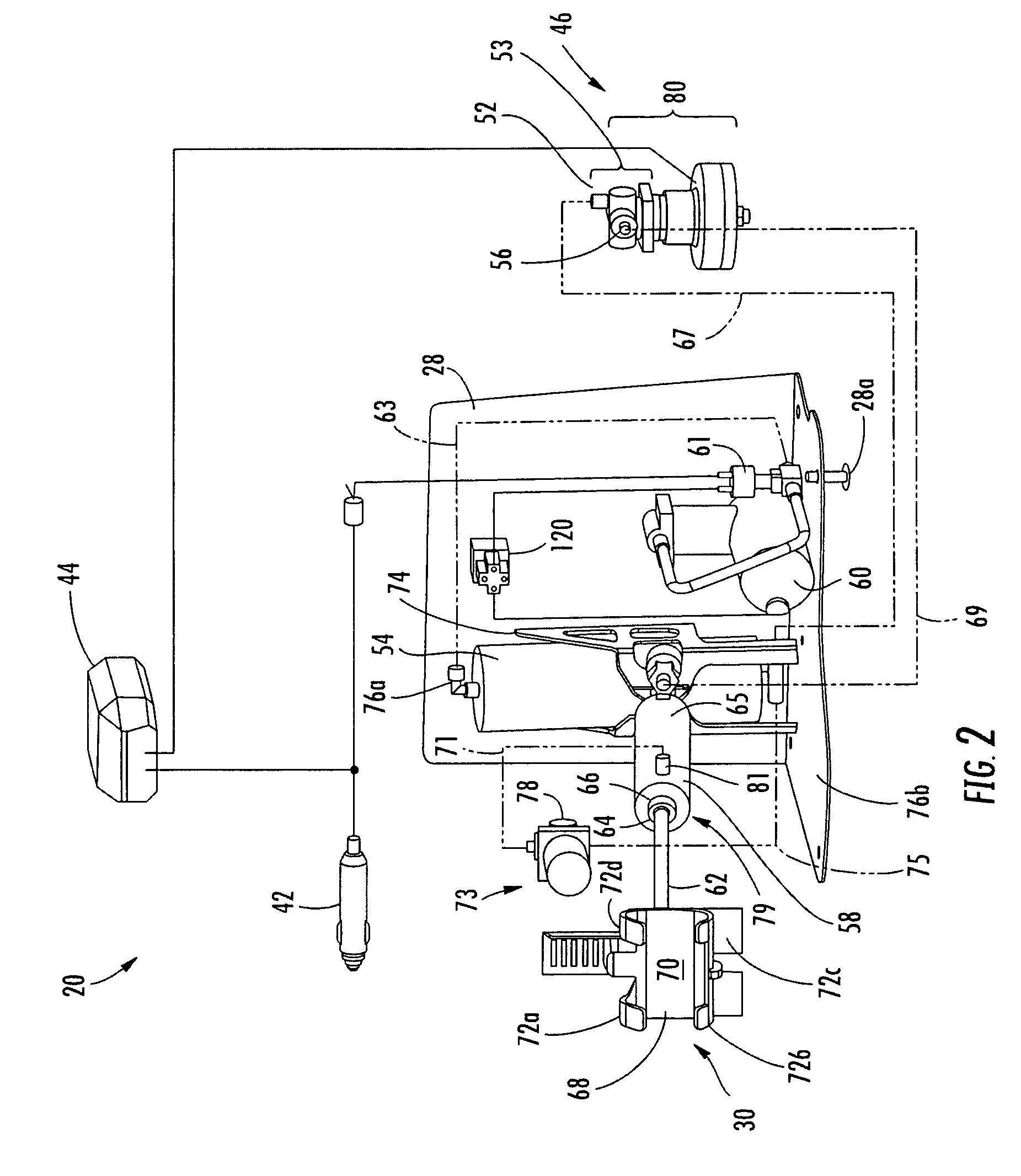This situation typically produces undue stress on the towing vehicle's braking system.
As a result, the
life span of the towing vehicle's braking system could be significantly shortened.
For instance, the brake pads of the towing vehicle could
wear out faster.
This situation may
pose a risk that the towing vehicle will lose its brakes, perhaps causing an accident.
Furthermore, significant stress on the vehicle connection system, such as the hitch, may result when the towing vehicle stops or slows down the towed vehicle.
If stress exceeds the structural strength of the hitch,
catastrophic failure of the hitch may result.
Some jurisdictions require the use of auxiliary braking systems, especially when the vehicle being towed is heavy.
At least one potential problem with the brake system in Latham is that different vehicles may require different brake pedal force or pressure to efficiently actuate their brakes and thus require different
pendulum weights.
A user of the braking system of Latham might find that the
pendulum weight included with the purchase is incompatible with the type of vehicle the user has.
Another possible problem with the brake system in Latham is that the weighted
pendulum does not allow much room for control.
At least one possible problem with the brake controller in Hensley is that it completely relies on an electric-based drive mechanism.
Electric-based drive mechanisms, such as the brake controller of Hensley, have a high power requirement, which may drain the battery of the towed vehicle, if used as a power source over a period of time.
Another potential
disadvantage is that the Hensley system is dependent on an input from the towing vehicle's brake pedal to actuate the towed vehicle's brakes.
In the event communication between the system sensor and the micro-controller is lost, the braking system could be unable to actuate the towed vehicle's brakes.
This could result in excessive wear on the brakes of the towing vehicle; in the failure of the linkage between the towed and towing vehicle; and / or in safety concerns due to inadequate braking power.
Another possible issue with the electrically powered auxiliary brake system like the Hensley invention is that a loss of electrical power during the brake activation by the electric powered system could improperly leave the brake system activated.
This unwanted braking of the towed vehicle during the towing could result in possible damage and resulting brake failure for the towed vehicle.
Yet another potential problem for the electrically powered auxiliary brake system like the Hensley system could be the possible accidental and unwanted activating of the brake system through a fault in the
brake light system of the towing vehicle.
If the Hensley system is electrically connected to the
brake light system of a towing vehicle that has a combined brake / running light system, the accidental energizing of the
brake light system could result in unwanted activation of the auxiliary braking system / towed vehicle's braking system, resulting in possible damage to or failure of the towed vehicle's braking system.
In addition to the problems identified above for electric-based drive mechanisms, the brake actuation system in Harner et al. is intrusive.
As one of ordinary skill may appreciate, the brake actuation system of Harner et al. requires substantial labor and time to install.
Using a vacuum source may be problematic.
First, the connection itself must be airtight; any leaks in the connection will cause the braking system of the towed vehicle to fail.
Second, the use of vacuum mandates extensive maintenance.
Third, a loss of vacuum in the master brake cylinder may cause the braking system of the vehicle with the Harner et al. brake actuation system installed therein to fail.
'
s system may not be compatible with, or may interfere with, the operation of at least some anti-lock braking systems (ABS).
At least one
disadvantage of this system is that the braking force applied to the brake pedal of the towed vehicle cannot be controlled.
Because the system described in Shuck is also vacuum operated, Shuck'
s system also suffers from the disadvantages of Harner et al.
Additionally, as described for the Hensley system, if the Shuck system is electrically connected to the brake light system of a towing vehicle that utilizes a dual filament
bulb for a combined brake / running light system, an electrical short or fault in the dual filament
bulb could accidentally cause the unwanted activation of the Shuck auxiliary braking system / towed vehicle's braking system leading to possible damage to or failure of the towed vehicle's braking system.
Thus, Greaves, Jr. suffers from the disadvantages of Shuck'
s system described above, such as incompatibility with ABS systems and lack of control on the force being exerted on the towed vehicle's brake pedals.
's system is also intrusive because it taps into the brake lines.
Furthermore, the microswitch activation requires a considerable amount of play in the tow hitch
assembly.
's microswitch activation may not work with some hitch assemblies having low tolerances or minimal play.
Additionally, as described for the Hensley and Shuck supplementary braking systems, if the Greaves, Jr. supplementary brake system is electrically connected to the brake light of a towing vehicle that utilizes a dual filament
bulb for a combined brake / running light system, an electrical short or fault in the dual filament bulb could accidentally cause the unwanted activation of the Greaves, Jr. auxiliary braking system / towed vehicle's braking system leading to possible damage to or failure of the towed vehicle's braking system.
 Login to View More
Login to View More  Login to View More
Login to View More 


